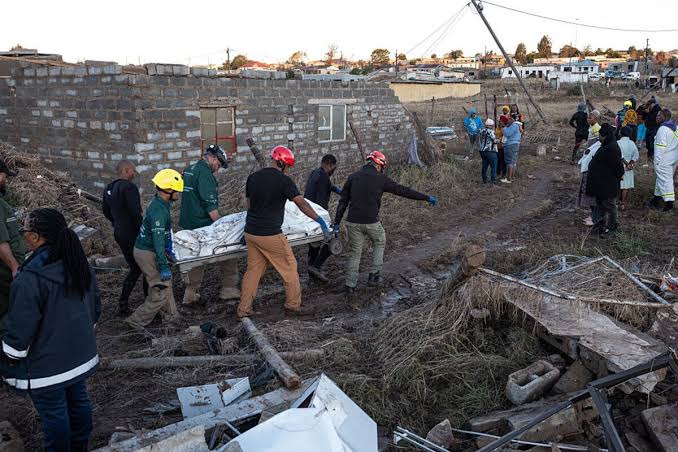 A powerful cold front swept through South Africa’s Eastern Cape early Tuesday, bringing torrential rains, strong winds, and even snow, triggering catastrophic floods across the region. As of today, the death toll stands at 78, with many more still missing and the count expected to rise as rescue operations continue in flood‑ravaged areas like Mthatha .
A powerful cold front swept through South Africa’s Eastern Cape early Tuesday, bringing torrential rains, strong winds, and even snow, triggering catastrophic floods across the region. As of today, the death toll stands at 78, with many more still missing and the count expected to rise as rescue operations continue in flood‑ravaged areas like Mthatha .
Mthatha has been particularly hard hit. Pre-dawn flooding caught sleeping residents off guard, with water reaching depths of up to 3–4 meters as swollen rivers burst their banks . Houses, vehicles, and even a school bus were swept away. Tragically, six pupils, their driver, and another adult on the bus perished; four students remain missing, though three others were rescued clinging to trees .
Rescue teams have been working tirelessly through debris and strong currents, recovering bodies as far as two kilometers from their last known locations . However, response efforts have been severely hampered. Eastern Cape Premier Oscar Mabuyane described them as “paralyzed” in the crucial first hours due to a shortage of resources—only one local rescue helicopter and no specialist divers or K9 units were available . Additional helicopters had to be brought in from hundreds of kilometers away.
The flooding also caused widespread displacement and infrastructure damage. Over 127 schools and some 20 health facilities have been damaged, and more than 1,000 people remain temporarily housed in relief centers . Many low-lying, informal settlements along rivers—where residents rely heavily on welfare—have been overwhelmed, triggering power outages and destroyed bridges and roads .
President Cyril Ramaphosa, who traveled to the province on June 13, acknowledged the immense human toll and pledged support, saying the tragedy “could have been much worse” . The National Disaster Management Centre has been activated to assist with coordination and response.
Authorities are urging residents to report missing loved ones to aid rescue efforts . Psychological support is now being offered to first responders and survivors, some of whom witnessed loved ones being washed away .
Critics have voiced concern that long-standing infrastructure neglect and underinvestment worsened the disaster’s impact—particularly in poorer, rural areas . Authorities had issued weather warnings days earlier, but coping with the volume and intensity of the flooding proved overwhelming.
As floodwaters begin to recede, rescue operations continue amid the devastation—a reminder of Eastern Cape’s vulnerability to extreme weather. The region has previously suffered deadly floods, including those in 2022 and June 2024, with climate change seen as increasing such threats .
In the wake of the disaster, provincial and national leaders face mounting pressure to improve early warning systems, invest in rescue infrastructure, and bolster support for communities in high-risk flood zones. For now, families are grieving lost loved ones, and survivors are picking up the pieces—with hopes that ongoing rescue efforts will bring some closure and guide a more resilient future.

